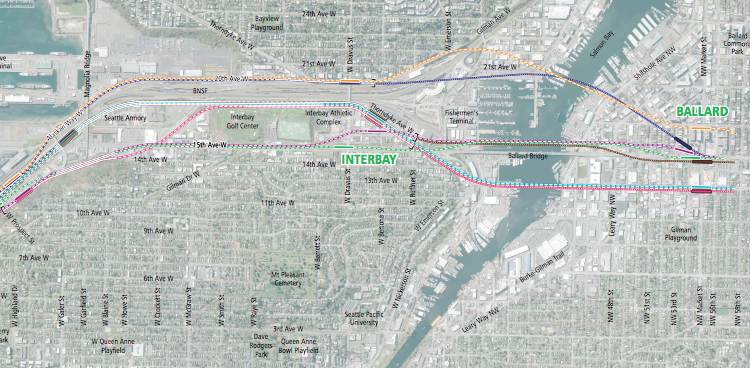There are several potential alignment schemes for the Ballard light rail, the most popular of which comes with a hefty price tag, as it turns out.
Sound Transit has just released its first cost estimates of the West Seattle-Ballard light rail extension, looking at three proposed alignments to link the two neighborhoods. In Ballard, the biggest questions are the Ship Canal crossing (either a tunnel, elevated bridge, or drawbridge) and where to put the Ballard station. What they came up with are two potential “mix and match” options, taking elements from several alignment proposals, as the Seattle Transit Blog reports.
In a chart released at a Stakeholder Advisory Group meeting this week, the two alignments include elevated bridges to reach both West Seattle and Ballard, or tunnels to reach both neighborhoods. An elevated fixed bridge over Salmon Bay on 14th Ave NW would cost an additional $100 million, while a tunnel under Salmon Bay would be an estimated $350 million. The full project cost of the elevated bridge alignment (in yellow and brown on the chart) would be $400 million above the original cost estimates.
The tunnel option would add a total of $2 billion above the ST3 representative project.
As the Seattle Transit Blog reports, Sound Transit’s project lead Cathal Ridge said a movable bridge could still be in the cards, but could have service interruptions and would have the most impact on other industry in the Ship Canal. A fixed bridge would avoid Ship Canal industry almost altogether, but would have to be at least 140-feet high. The tunnel would have the least impact on maritime, but would require third-party funding.
In the two mix-and-match proposals, the Ballard station alignment would be at NW Market St — either at 15th Ave NW, or be an elevated station at 14th Ave NW.
The advisory group and elected officials are expected to make recommendations in April, and final alignment decisions will be made by the Sound Transit board.




I think a tunnel is fine, but there will be additional revenue required to pay for it. I think if we Ballardites want to have it, then it should be up to us to pay for it.
I’ve heard ST3 is already over budget, so, even if they choose the less expensive option, we’ll probably pay more for it than we already are. Here, let me try out their new slogan: “want more? ST4!”
It’s inevitable and welcome!
I’ve heard ST3 is already over budget…
Do you have a source for this?
I follow ST projects pretty close and haven’t heard of ST3 being over budget. That would be surprising, considering almost all ST3 projects are still in the early planning phase.
I really dislike how they’ve lumped the West Seattle and Ballard tunnels into one “package”. The tunnel under Salmon Bay would add $350M over the movable bridge per ST3. The West Seattle Tunnel alone is $500M-$700M. Lumping these together along with the more expensive options in the International District and calling it a $2B increase makes the Ballard tunnel option seem very unreasonable, when in fact the Ballard tunnel is not even 20% of that number over the ST3 alignment.
So, are they trying to further delay the Ballard link, by not mentioning the cost-grouping issue? Seems to me it’s a way for them to say “well, gosh, you voted for it, aren’t you willing to pay just a bit more”? Wanna Pay More? ST4!
Seems like you are being intentionally deceptive.
“The tunnel under Salmon Bay would add $350M over the movable bridge per ST3.” – Not the cost of the tunnel, just the increase. No biggie, that part is fine on it’s own.
The West Seattle Tunnel alone is $500M-$700M. So now we are switching to total cost, hmm, shady.
Oh, each number is an increase. Ballard tunnel adds $350M, West Seattle adds $500M-$700M depending on the route. Sorry for being unclear there
It is a fair point that Sound Transit is vague on what the baseline cost for each component is, which makes it difficult to compare how big the increases are to the total cost.
Complete waste of money.
Tell that to the many thousands who rely on the incomplete system so far….should have been done in the sixties!